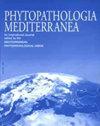Pseudomonas syringae pv. syringae causes bacterial canker on Japanese quince (Chaenomeles japonica)
IF 1.9
3区 农林科学
Q2 AGRONOMY
引用次数: 0
Abstract
Japanese quince trees are grown as ornamental plants in Iran, in parks and in orchards close to stone fruit and pome fruit trees. Shoots of Japanese quince (Chaenomeles japonica) showing sunken brown canker symptoms were observed and collected near Sari, the center of Mazandaran province in the North of Iran, during the 2016 growing season. Gram negative bacteria isolated from symptomatic tissues were similar to Pseudomonas syringae pv. syringae (Pss) were pathogenic on Japanese quince and on quince (Cydonia oblonga) seedlings after artificial inoculation, and were re-isolated from diseased hosts. Phylogenetic tree construction using partial sequences of ITS and rpoD genes showed that the Japanese quince isolates were in the same clade as Pss strains. The isolates had ice nucleation activity, and the InaK gene was amplified successfully. According to the results of phenotypic and genotypic characteristics, genomic DNA fingerprinting using REP-PCR, BOX-PCR and IS50-PCR and isolation of total cell proteins, we conclude that Pss is the causal agent of canker of the Japanese quince trees. Therefore, Japanese quince is a new host for Pss causing bacterial canker on many different host plants.丁香假单胞菌。丁香引起日本木瓜细菌溃疡
在伊朗,日本榅桲树是作为观赏植物种植的,在公园和果园里,靠近核果和梨树。2016年生长季,在伊朗北部马赞达兰省中心萨里附近,观察并采集了显示凹陷棕色溃疡症状的日本榅桲(Chaenomeles japonica)嫩芽。从症状组织中分离的革兰氏阴性菌与丁香假单胞菌相似。经人工接种后,丁香菌(syringae, Pss)对日本榅桲和榅桲(Cydonia oblonga)幼苗具有致病性,并从病宿主中重新分离得到。利用ITS和rpoD基因的部分序列构建系统发育树,结果表明,该菌株与Pss属同一支系。分离株具有冰核活性,成功扩增出InaK基因。根据表型和基因型分析结果,结合REP-PCR、BOX-PCR和IS50-PCR的基因组DNA指纹图谱和细胞总蛋白的分离,我们认为Pss是导致太子柏树溃疡病的病原。因此,太子参是Pss的新寄主,可在多种寄主植物上引起细菌性溃疡病。
本文章由计算机程序翻译,如有差异,请以英文原文为准。
求助全文
约1分钟内获得全文
求助全文
来源期刊

Phytopathologia Mediterranea
生物-植物科学
CiteScore
4.40
自引率
8.30%
发文量
28
审稿时长
6-12 weeks
期刊介绍:
Phytopathologia Mediterranea is an international journal edited by the Mediterranean Phytopathological Union. The journal’s mission is the promotion of plant health for Mediterranean crops, climate and regions, safe food production, and the transfer of new knowledge on plant diseases and their sustainable management.
The journal deals with all areas of plant pathology, including etiology, epidemiology, disease control, biochemical and physiological aspects, and utilization of molecular technologies. All types of plant pathogens are covered, including fungi, oomycetes, nematodes, protozoa, bacteria, phytoplasmas, viruses, and viroids. The journal also gives a special attention to research on mycotoxins, biological and integrated management of plant diseases, and the use of natural substances in disease and weed control. The journal focuses on pathology of Mediterranean crops grown throughout the world.
The Editorial Board of Phytopathologia Mediterranea has recently been reorganised, under two Editors-in-Chief and with an increased number of editors.
 求助内容:
求助内容: 应助结果提醒方式:
应助结果提醒方式:


